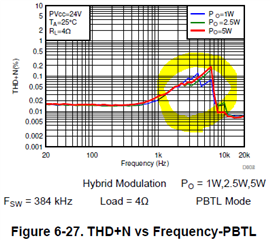Hi team,
I have a basic question. Why THD+N goes up at 1K to 10K band and back to low again at upper 10K band? I assume that harmonics caused this phenomenon. Is this right?

Thanks!
Jay
This thread has been locked.
If you have a related question, please click the "Ask a related question" button in the top right corner. The newly created question will be automatically linked to this question.
Hi team,
I have a basic question. Why THD+N goes up at 1K to 10K band and back to low again at upper 10K band? I assume that harmonics caused this phenomenon. Is this right?

Thanks!
Jay
Hey Jay,
Could you specify the device this figure relates to?
Best Regards,
Carson
LPA Applications Engineer
Hi Carson,
Thanks for your reply.
I took that figure from TAS5825M datasheet. But It seems that every MPAA devices has similar characteristics.
BR,
Jay
Hi Jay,
Okay I am going to transfer you to the right forum (Mid power audio) MPA formerly MPAA because this is LPA forum
Best Regards,
Carson
Hi Jay
The digital sample rate and the PWM frequency are all fixed when we testing this THD diagram. From digital processing theory and also PWM theory, if the output frequency more close to the sample or PWM frequency, there would be more distortions. So the THD would be higher when the frequency goes up. But when the frequency higher than 6.67KHz, it's 3rd harmonics would beyond 20KHz, that is the audio range. We use an additional low pass filter at 20KHz to get rid of noise that is beyond audio range, that's standard method to test audio amplifier. So you'd see when frequency higher than 6.67KHz, THD will become small again, that is because the filter takes effect.
Jay,
Let's move it offline and let Shadow deliver a training on this for you.
Dylan